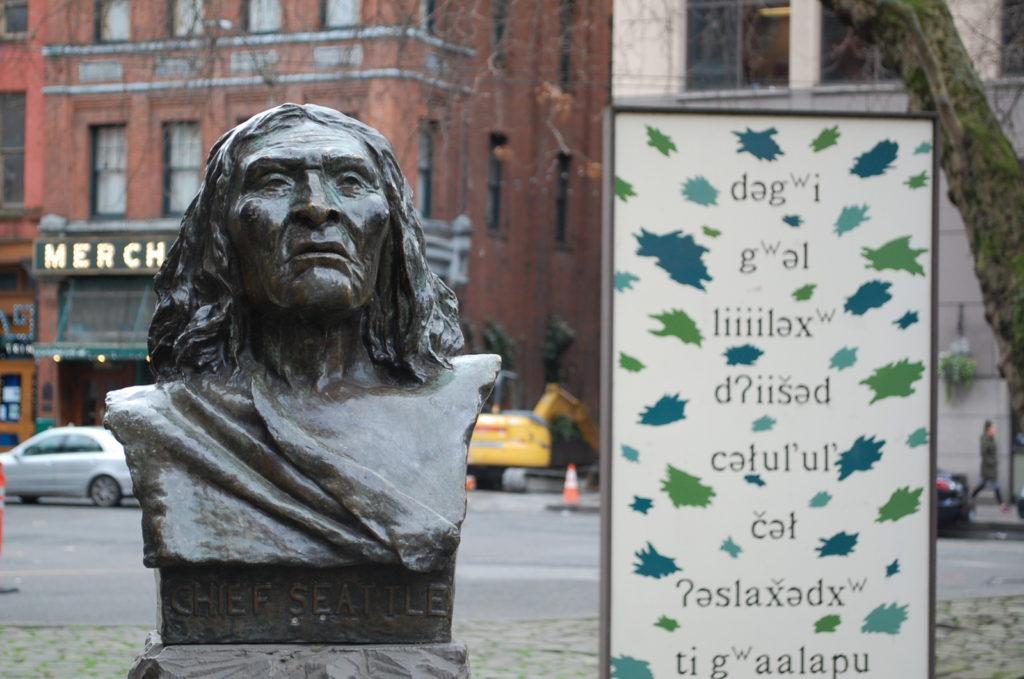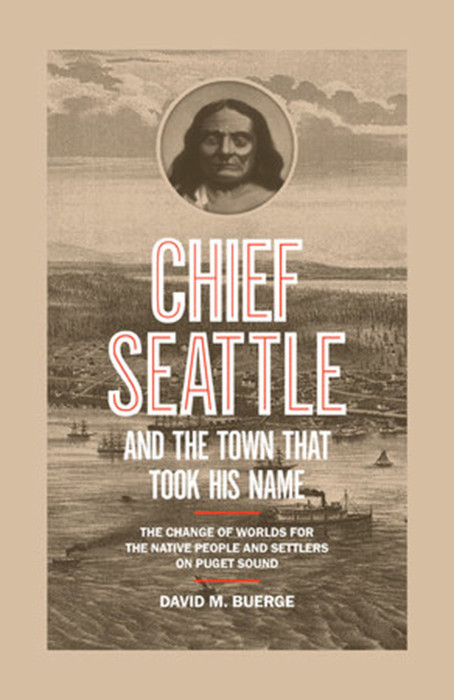“Chief Seattle and the Town That Took His Name:The Change of Worlds for the Native People and Settlers on Puget Sound”
By David M. Buerge, Sasquatch Books, 325 pp., $25.95
Chief Seattle, the 19th-century leader of the Duwamish and Suquamish tribes, and the man for whom our city was named, grew up in Kent.
This, of course, was long before the suburban Seattle town existed. But one of the startling things about historian David M. Buerge’s new biography of Chief Seattle is the way he brushes aside the sprawling Olympia/Tacoma/Seattle/Everett megalopolis we all know and reveals the complex, faction-ridden indigenous society of 200 hundred years ago that covered the same territory.
“Chief Seattle and the Town That Took His Name: The Change of Worlds for the Native People and Settlers on Puget Sound” focuses keenly on the geopolitical realities that the tribes around the Sound inhabited before the first significant European incursions. It also spells out the many phases that native-settler relations went through between the 1820s and 1860s, with Chief Seattle (c. 1786-1866) playing a key role through most of them.
In his introduction, Buerge acknowledges the hurdles he faced in writing the biography of a man whose early life predates most written historical records. Seattle first appears in the annals in 1832 as “a brawny Soquamish with a roman countenance & black curley hair, the handsomest Indian I have seen.” Twenty years later, another eyewitness dubbed him “one of the most sensible and influential chiefs on the Sound.” But hard archival evidence about the man from before the 1850s is hard to come by.
“Indeed,” Buerge notes, “the paucity and ambiguous nature of what we know about Seattle has allowed him to be refigured to suit a variety of purposes. He has been described as a war leader, a peacemaker, a gifted orator, a savage who communicated only in signs and grunts, a friend, a traitor, a drunk, a supporter of temperance, a religious leader, a philosopher, and an environmental saint.”
Even the pronunciation of his name is in question. Its last syllable, Buerge tells us, is “a voiceless lateral alveolar fricative.” (I think this means that if you say “Seattle” in a Cockney accent, you’re close to the mark.)
While specifics on Seattle’s early life are sparse, considerable detail of the world he grew up in has been uncovered through anthropological and archaeological studies. True, the evidence is fragmentary. But thanks to Buerge’s and his predecessors’ intelligent guesswork, a credible character for Chief Seattle emerges from the space between the fragments.
“Ambiguity,” Buerge declares, “is his hallmark.”
Those ambiguities extend beyond his interactions with white settlers to his status within his own society—for Seattle, significantly, was the offspring of a tribal chief and his slave, a source of potential stigma which he seems to have overcome.
He was born into a world already devastated by a European-introduced smallpox epidemic in 1775. But disease wasn’t the only deadly force in Puget Salish society. Long-standing tribal enmities between Sound residents and raiders from Vancouver Island and points north also took their toll.
Buerge is frank about how vicious these confrontations could be. When the Lekwiltok of Vancouver Island conducted raids on Whidbey Island, for instance, an alliance of the Skagit, Snohomish and Lummi tribes didn’t hold back in seeking vengeance.
“Smoke rising above an island in the Gulf of Georgia guided them to a potlatch, where the attackers surrounded the unsuspecting gathering, rushed forward, and slaughtered everyone, leaving a row of heads on the beach as their calling card.”
One thing the book makes clear, as it recounts these bloody conflicts, is the mobility afforded by the marine highway that is the Salish Sea. Seattle’s own turf ranged from what is now Olympia to the Fraser River (where he regularly went on fall fishing expeditions). He seems to have been in contact with neighboring tribes, white settlers, Catholic missionaries and government officials everywhere up and down the Sound. While he took part in intertribal hostilities in his youth, he evidently came to see them as self-defeating for the region’s native peoples.
The traditional diplomatic solution to this bloodshed was intertribal marriage – and Seattle, apparently, was a dedicated matchmaker. In this same spirit, he encouraged white male settlers to marry native women. (Historian Candace Williams covered this ground in her recent book, “Peace Weavers: Uniting the Salish Coast through Cross-Cultural Marriages.”)
Buerge believes Seattle specifically wanted to create “hybrid-racial communities to expand trade in central Puget Sound.” And while our region, between the 1830s and 1860s, was, as one historian aptly put it, “an evolving colonial world where neither the people nor the relations among them remained fixed for long,” at certain intervals Seattle’s goal seemed achievable.
Here’s how things stood in the mid-1840s: “Bachelors took native wives, which gave them a voice at council meetings. To the settlers, the Indians seemed more like them than [Britain’s] mercenary Hudson’s Bay Company men. To the Indians, the Americans, if odd, were energetic and resourceful, and, more importantly, they had items to trade that challenged the HBC monopoly.”
These alliances and power balances never stayed still for long. The white population kept increasing. The tribes were divided on how to react to this. Tensions mounted and erupted in the original Battle of Seattle in 1856, when Klickitat warriors from east of the Cascades attacked white settlers, undoing Seattle’s attempts to keep harmony between his people and the whites. Settler Catherine Maynard recalled the 70-year-old chief making “pitiful demonstrations of the anguish he was in.”
The violence – which made national news – slowed white immigration to the region for a decade, Buerge notes, “allowing the hybrid community, however challenged, to survive.” Even in the 1860s, the future city struck a newcomer as “a very small village, really more Indian than white.” But after the American Civil War was over and some San Juan Islands border disputes between the U.S. and Britain were resolved, the flow of Americans into the region vastly increased and never abated.
The Suquamish gained their own reservation on the western shore of Puget Sound, but Seattle’s alliance with the settlers turned out to be a very bad deal for the Duwamish. While most hostile tribes were able to win reservation lands when they came to the bargaining table, Seattle, who’d been made endless promises about keeping tribal land along the Duwamish River, wound up with nothing for the Duwamish: no reservation, no official tribal recognition (a state of affairs that continues to this day).
The nadir came in 1865, when native people were essentially banned from living inside Seattle’s town limits.
Chief Seattle, retreating to the Suquamish reservation, died in 1866. His death went little noticed at first. His extraordinary afterlife as a cultural icon only took shape decades later. Its catalyst was a speech he gave in 1854, questioning the restless, rapacious nature of the culture that threatened to supplant his. Buerge’s parsing of that speech, and all the various versions it went through in hands of later white translators and interpreters, supplies a key thread to the book.
“Chief Seattle and the Town That Took His Name” does a thorough job of evoking how one complex world was succeeded by another. But in its first half, the action is sometimes tough to follow, given how many shifting tribal factions were in play (many more than I’ve named here).
Buerge’s use of native names for key locations and players is laudable, but can be challenging. He does provide maps and a glossary, but it still can be difficult to keep the distinctions clear between “Txwchɘ’kup” (Agate Passage) and “Txwkwi’ltɘd” (a village on the Duwamish River). And his index isn’t as complete as it should be to be helpful.
The triumph of the book is the way it gives us a living, conflicted figure who did the best he could with the circumstances he was dealt.
“Seattle was too invested in his hybrid community to portray his people as anything other than the vigorous partners they were,” Buerge concludes. “He sought to hearten them, not bewail their demise. By his constant efforts to involve them in an emerging economy, we understand that he did not see them disappearing anytime soon.”
Proportionally, their numbers may be much reduced. But they’re still with us – and in many cases, given that history of cross-cultural marriages, they are us.
Novelist Michael Upchurch (Passive Intruder) is the former Seattle Times staff book critic. Visit him at www.michaelupchurchauthor.com.
Photo credit: Bust of Chief Seattle and Edgar Heap of Birds’ “Day/Night” by Andrew Engelson
Did you find this review informative? If so, please take a moment to help support the writers who make stories like this possible:


